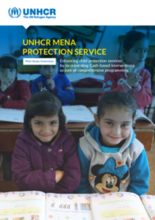Children account for 2.5 million (almost half) of the Syrian refugee population, and child protection remains a core element of UNHCR’s protection response.
UNHCR has been promoting research projects aimed at assessing the contribution of different cash assistance modalities for enhancing child protection outcomes and improving the well-being of refugee children and their households. UNHCR cash assistance programs in the MENA region are some of the largest and most advanced cash programs in the world. UNHCR distributed over US$ 230 million in cash assistance across the region in 2018, reaching some one million individuals. CBI represent an important component of a much broader and integrated network of activities and services provided by UNHCR to provide protection and assistance to the most vulnerable. Existing vulnerability assessment tools such as the Vulnerability Assessment Framework in Jordan (VAF), Vulnerability Assessment for Syrian Refugees in Lebanon (VASyR) and Egypt Vulnerability Assessment of Refugees (EVAR) used for identification of vulnerability focus mainly on socioeconomic factors, with limited weight given to specific protection needs such as child protection or prevention, risk mitigation and response to sexual and gender based violence (SGBV). Separate pathways for CP and SGBV referrals have been developed to address the need to include families provided with child protection case management services among beneficiaries of cash assistance programmes. The region has a critical mass of data that can be analysed to better understand the impact of cash transfers on mitigating protection risks among children.
Drawing on this evidence base, UNHCR has a comparative advantage in effectively delivering CBI as a protection tool that is informed and optimised based on robust protection data, and is well-integrated into complementary protection interventions, including case management and other assistance services.
The following are the results from multi-country research launched in 2018 on refugee data in Egypt, Jordan and Lebanon to study the impact of CBI on child protection outcomes. MENA Protection Service and the CBI Unit recently finalized this research project that aimed to demonstrate the impact of cash assistance modalities as a key protection tool to prevent and respond to child protection risks.
These studies were initiated in recognition of the fact that socio-economic vulnerability can increase significantly as the displacement of refugees becomes more protracted, leading to an array of protection concerns, including significant protection risks for children. The Syria crisis was identified as a particularly opportune context to examine as Syrian refugees are contending with increasing socio-economic vulnerability linked to increased indebtedness, the depletion of savings and limited livelihoods opportunities—a situation that has increased the vulnerability of women, girls, men and boys to a broad range of protection risks and negative coping strategies. In Jordan, for instance, 82% of Syrian refugees now live below the poverty line, and 79% resort to harmful coping strategies such as child marriage and child labour. Similarly, Lebanon has witnessed a sharp rise in a spectrum of severe negative coping strategies among displaced Syrian families, from 28% in 2014 to 67% in 2015, which include begging, the removal of children from school, child marriage, the worst forms of child labour and even survival sex. As of 2018, nearly all (96%) of displaced Syrian families in Lebanon rely on some form of negative coping strategy to meet their basic needs.
Noting the strong nexus between poverty and protection, the research in Lebanon focused on examining the impact of cash assistance as a key tool to prevent and mitigate child labour. While in Jordan and Egypt, the studies aimed to identify dynamics contributing to children’s exposure to violence, abuse, exploitation and neglect (coded in UNHCR’s proGres-database as “LPAN”), with a view to identifying profiles that are more susceptible to child protection risks. The studies have generated an invaluable analysis of household (HH) coping strategies and the exposure of children to risks or incidents of violence, abuse, neglect and exploitation. This results of these studies provide evidence of the need to strengthen identification of children at risk, to harmonize referrals and to standardize cash assistance with protection-centred data, and to develop technical guidance on the design of UNHCR CBI, along with complementary protection interventions and services, to contribute to enhanced protection for children involved in child labour or facing other protection risks.

